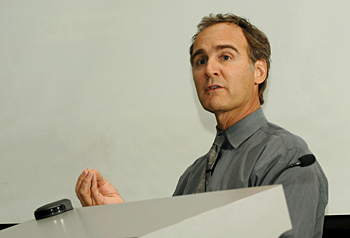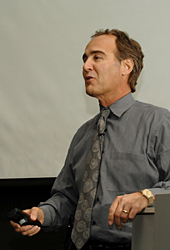
Speaking to about 100 students and faculty, Burns said the growing demand for oil and fluctuating prices have created serious concerns for the automobile industry, which is almost totally dependent on gasoline.
“We are in a situation where energy is at the heart of the future of the world,” Burns said, adding that demand for petroleum is expected to grow by 70 percent in the next 23 years. “If we have energy security concerns today, imagine what those concerns are going to be in the year 2030. If you are in the auto business where we are 98 percent dependent on petroleum for our energy sources, imagine the business risk in not having solutions to these issues.”
Burns said General Motors has embarked on a major research and design strategy aimed at playing a leading role in the automobile industry while maintaining business sustainability.
“It's really time to seize this opportunity and the opportunity that technology brings,” Burns said. “We are seeking to improve the fuel efficiency and emissions of our vehicles. Essentially, we want to have zero-emission vehicles, and we want to get the car out of the energy/environmental debate. We believe the way to do that is to displace petroleum. The key to displacing petroleum is energy diversity, using petroleum and alternative sources of petroleum, biological and synthetic fuels and hydrogen and electricity.”
Burns said GM already has about two dozen vehicles in the market whose fuel consumption averages more than 30 miles per gallon on the highway. The higher efficiency, he said, has been made possible by innovations like active fuel management, in which some engine cylinders shut off when a vehicle is cruising at highway speeds, as well as energy-efficient six-speed transmissions.
Some 2 million GM cars and trucks on the road can use flex-fuel--a combination of 81 percent ethanol and 19 percent gasoline--and 400,000 more are being sold every year, Burns said. The growing use of ethanol, he said, will not only ease dependence on petroleum, but it will create many opportunities to make ethanol from cellulose, which occurs naturally in plant cell walls.
In contrast, Burns said, Toyota will not produce a vehicle that can run on 85 percent ethanol until the year 2010. “That's how much of a lead we have,” he said.
“The whole principle here is to create jobs in the United States by creating alcohol from cellulose, keep the dollars going outside the United States to buy petroleum here to drive our economy, and use a renewable source of energy that requires carbon dioxide [to be] removed from the atmosphere to grow those plants,” Burns said.
In addition to flex-fuel, GM is developing more electric hybrid vehicles, beginning with the introduction of 550 of the company's Allison hybrid buses since 2003. The buses use energy created from braking to charge a power source for the motor, Burns said. Electric hybrid technology has been built into the Saturn Vue and the same system will be put in the Saturn Aura and the Chevrolet Malibu.

GM also is focusing on the development of variations of the electric hybrid engines to include electric power sources that can be charged from electricity mains. Such technology has been used in the Sequel, “the world's most advanced” hybrid vehicle, which travels up to 300 miles on its hydrogen supply, and accelerates to 60 miles per hour in less than 10 seconds.
Burns praised UD for its role in the development of a hydrogen fuel cell bus that was recently unveiled on the Newark campus and said that such technology is a major part of GM's strategy.
“It is very, very nice to see that you have a hydrogen fuel cell bus running here on your campus,” Burns said. “You need to be enormously proud of that fact. There are not many of those buses that exist in the world and to be able to experience this cutting-edge technology firsthand and, importantly, to have created the relationships that allows you to get this bus built and on your campus is something that you should be very proud of.”
In addition to fuel sources, GM is also developing smart car systems, such as enhancing the use of the OnStar navigation and emergency assistance systems available on most GM vehicles by linking it to stability control systems.
“Stability control is based on steering movement, speed and chassis movement,” Burns said. “We can share that data between cars and predict where the car will be in the next 20 milliseconds. When we know where the cars are now, we know where they will be, and we can avoid crashes. We can also keep the space between cars uniform and improve traffic. Vehicle-to-vehicle communication is very exciting technology that General Motors is pioneering.”
Burns, who oversees GM's advanced technology, innovation programs and corporate strategy, began his career in 1969 as a member of the company's research and development staff, where his research focused on transportation, logistics and production systems. He has held executive positions in several GM divisions in the areas of product program management, quality, production control, industrial engineering and product and business planning. In May 1998, he was named a vice president of General Motors, with responsibility for research and development and planning.
Burns holds a doctorate in civil engineering from the University of California at Berkeley. He also has a master's degree in engineering/public policy from the University of Michigan and a bachelor's degree in mechanical engineering from General Motors Institute (now Kettering University).
Article by Martin Mbugua
Photos by Duane Perry


